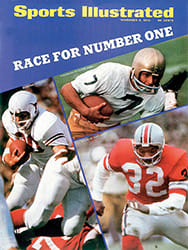
Not Every Bloomer Held A Girl
There is no way of knowing what Amelia Jenks Bloomer, the 19th century precursor of today's militant bra burners, thought of the baseball teams that were named after her, or even if she ever saw them play. Her vaunted "uniform of liberation" degraded into a mere gym suit, the lady who in the 1850s sought to free her sisters by putting them in harem pants instead of skirts had pretty much passed into oblivion by the time women's baseball really got going, for it was not until the 1880s that women's rights were extended to the baseball diamond.
One of the first officially recorded distaff games was played in 1883 when two all-girl teams from Philadelphia, the Blondes and the Brunettes, met in Newark, to the detriment of the Blondes, who lost by a score of 40-22. Unaware of Mrs. Bloomer's valiant efforts to set them free, however, the ladies of both teams took the field in flowing skirts.
It was not until 25 years later that the first Bloomer Girls played daringly clad in a streamlined version of Amelia's flowing Turkish pantaloons and changed the whole aspect of the women's game. In 1927 the American Physical Education Association devised a set of rules for outdoor women's baseball, an effort that led eventually to the development of several all-girl leagues. But this was sissy stuff compared to the sport pursued almost a quarter of a century earlier by the free-swinging Bloomer Girls. Asking no special favors, these women toured the country playing a man's game by men's rules against men.
Like "Harry's Hell Drivers" at some local country fair today, "Bloomer Girls" was a name without copyright; it was used indiscriminately by any number of enterprising promoters to signify all sorts of motley collections of barnstorming ballplayers trying to scratch a buck out of the sandlots of early 20th century America. One such outfit, called the Texas Bloomer Girls, included seven girls, four boys with two arms each and a fifth boy with only one arm who played centerfield. "I guess you heard of this boy," wrote the Texas Bloomer Girls' manager in a long letter to a prospective backer. "He was the feature of the game last season when we defeated the Weidamans 7-2 and we defeated the strong Madison and Richmond, Ind. teams. We have two girls who are pitchers, Miss Grace who was a southpaw and Miss Coon of Dayton O and we have a man pitcher and he is a southpaw also, and we ask you if you want to make some money, this is one of the best ways to make it. You get the games for us we would like to play every day ball, you can make about three hundred dollars clear money every week. I guess I will close for this time. Hoping to hear from you I remain yours."
Not all Bloomer Girl managers were honest enough to state beforehand that they laced their lineup with men. Fairly frequently, players who took the field as Bloomer Girls were in fact Bloomer Guys, dressed in appropriate wig and costume. One Clarence Wortham of the New England Bloomer Girls, according to his manager, made "as handsome a girl as any boy on the team." Clarence's team found it easier than many to foster this innocent charade, since it played many of its games at night under gas lanterns that according to the advance billing "turned night into day" and made the dustiest diamond glitter with "bright, white light."
From the point of view of sportsmanship it seems only fair that Bloomer Girl teams should have been permitted a man or two in their ranks, because their opponents were always men. What's more, they occasionally beat them. An article in the Literary Digest of July 28, 1923 noted that "one of the best semi-professional man's baseball teams in New Jersey" lost to the Kansas City Bloomer Girls in a stunning upset.
One advantage all Bloomer Girls got from never playing each other in any kind of organized league was the fact that each team could claim itself as "the champion." The Bloomer Girls of Boston went so far as to boast that they were "not only the Amateur champions of the United States and Canada but likewise of the independent class."
Constantly on the road, these Bostonians once played 28 games in 26 days without a loss. Their streak began in Sapulpa, Okla. on July 3 with an 8-1 win. The following day they swept a July 4 doubleheader from an embarrassed Tulsa team 11-0 and 11-3. This was followed by consecutive shutouts in Skiatook, Owasso and Ochalata and continued with a perfect run through Kansas that included another doubleheader sweep of 7-2 in an afternoon game in Almena and 9-5 in an early evening contest in Norton, 11 miles away.
Whatever the rewards of such a vagabond life, the constant traveling and quick-stop diners would have been difficult for most men, and certainly only a special breed of woman could endure it. One manager claimed his "Tennessee girls were equally talented at playing baseball and chewing tobacco." "This," he added, "pleased the customers a whole lot."
An even more virile crowd were the New York Bloomer Girls who, in 1913, ended a tour of North Carolina by wrecking a hotel in Raleigh. The carnage began when they demolished the windows, mirrors and chairs. When the proprietor demanded payment for the damage, the Bloomer Girls not only refused to pay but turned on him as well, and when the town's only police officer came to the rescue he met a barrage of "shoes, bats, masks and baseball weapons."
Such on- and off-the-field antics lent the Bloomer Girls a sideshow appeal that organized baseball could not provide. Perhaps it did not draw baseball fans so much as it drew the curious, but it did draw. Even the fans could be counted on to provide a certain amount of ribald entertainment, such as when a wig came flying off and indignation at a suddenly hairless Bloomer Girl swelled into outrage. One set of distrustful fans stormed the playing field before a game to yank at the hair of the players, one of whom—name of Rosie—decked a skeptic with a convincing left.
Since Rosie's day, women's baseball, such as it is, has suffered the dignities of organization and codification in softball leagues and women's colleges. And this, perhaps, is good. But it's just possible that Amelia Bloomer would have preferred the rough-and-tumble of the game played by her namesakes.

